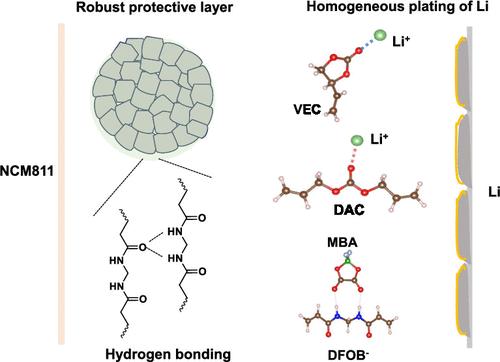利用焓熵操纵进行固体聚合物电解质的分子设计,用于具有侵蚀性阴极化学成分的锂金属电池
IF 15.6
1区 化学
Q1 CHEMISTRY, MULTIDISCIPLINARY
引用次数: 0
摘要
固体聚合物电解质(SPEs)具有高离子传导性、高锂+转移数和宽电化学窗口,有望用于下一代高能锂金属电池(LMBs)。在此,我们介绍了一种焓熵操纵策略,通过对聚合物骨架进行分子设计,实现了一类可调节阳离子/阴离子溶解度的聚碳酸酯基共聚物电解质(PCCEs)。通过在聚合物骨架中整合一个弱溶解性线性碳酸盐和另一个强溶解性环状碳酸盐段,Li+ 离子(与两种羰基)的阳离子-偶极配位被削弱(低焓罚)和非定向(高熵罚),从而实现了 Li+ 的弱溶解和快速扩散。我们进一步引入了基于双丙烯酰胺的交联段,该交联段除了能提供高机械强度外,还能与二氟(草酸)硼酸阴离子形成二氢键,这种键是强键(高焓罚)和定向键(低熵罚),从而限制了阴离子的迁移。因此,PCCE 在 25 °C 时具有 0.66 mS cm-1 的高离子电导率和高 Li+ 转移数(0.76),以及高氧化稳定性。通过原位聚合方法,PCCE 使使用高镍钴锰酸锂 0.8Co0.1Mn0.1O2 阴极的 LMB 在截止电压为 4.5 V 的条件下,经过 800 次循环后仍能保持 82.2% 的高容量,而使用侵蚀性 LiNi0.5Mn1.5O4 阴极的 LMB 在截止电压为 5.0 V 的条件下,经过 300 次循环后仍能保持 96.4% 的容量。所描述的焓熵操纵方法为高能锂金属电池高性能固相萃取剂的分子设计提供了一个独特的视角。本文章由计算机程序翻译,如有差异,请以英文原文为准。

Molecular Design of Solid Polymer Electrolytes with Enthalpy–Entropy Manipulation for Li Metal Batteries with Aggressive Cathode Chemistry
Solid polymer electrolytes (SPEs) with high ion conductivity, high Li+ transference number, and a wide electrochemical window are promising for the next-generation high-energy Li metal batteries (LMBs). Here we describe an enthalpy–entropy manipulation strategy enabling a class of polycarbonate-based copolymeric electrolytes (PCCEs) with regulated cation/anion solvation via a molecular design of the polymer backbone. By integrating a weakly solvating linear carbonate with another strongly solvating cyclic carbonate segment in the polymer backbone, the cation–dipole coordination for Li+ ions (with two types of carbonyl groups) is weakened (low enthalpy penalty) and nondirectional (high entropy penalty), which enables a weak solvation and rapid diffusion of Li+. We further introduce a bis-acrylamide-based cross-linking segment which, other than imparting high mechanical strength, exhibits dihydrogen bonding with the difluoro(oxalate) borate anions, which is strong (high enthalpy penalty) and directional (low entropy penalty), thus restricting the migration of anions. As a result, the PCCE delivers a high ionic conductivity of 0.66 mS cm–1 with a high Li+ transference number (0.76) at 25 °C, as well as high oxidation stability. By an in situ polymerization approach, the PCCE enables LMBs using high-nikel LiNi0.8Co0.1Mn0.1O2 cathodes with a high capacity retention of 82.2% over 800 cycles with a cutoff voltage of 4.5 V and further LMBs using aggressive LiNi0.5Mn1.5O4 cathodes with a 96.4% capacity retention over 300 cycles with a cutoff voltage of 5.0 V. The described enthalpy–entropy manipulation approach offers a unique perspective for the molecular design of high-performance SPEs for high-energy Li metal batteries.
求助全文
通过发布文献求助,成功后即可免费获取论文全文。
去求助
来源期刊
CiteScore
24.40
自引率
6.00%
发文量
2398
审稿时长
1.6 months
期刊介绍:
The flagship journal of the American Chemical Society, known as the Journal of the American Chemical Society (JACS), has been a prestigious publication since its establishment in 1879. It holds a preeminent position in the field of chemistry and related interdisciplinary sciences. JACS is committed to disseminating cutting-edge research papers, covering a wide range of topics, and encompasses approximately 19,000 pages of Articles, Communications, and Perspectives annually. With a weekly publication frequency, JACS plays a vital role in advancing the field of chemistry by providing essential research.

 求助内容:
求助内容: 应助结果提醒方式:
应助结果提醒方式:


